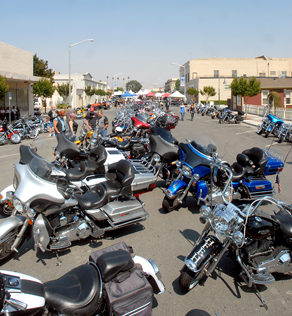
Rally a boon for some businesses, but a cost to the city
The Hollister Independence Rally has been a sanctioned event for
10 years
– with a one year break in 2006 – but it has a history that goes
back 60 years.
Rally a boon for some businesses, but a cost to the city
The Hollister Independence Rally has been a sanctioned event for 10 years – with a one year break in 2006 – but it has a history that goes back 60 years.
In 2007, city officials partnered with Horsepower Promotions to reformat the rally, a move that took motorcycles onto the side streets and turned the main drag into a vendor tent city. The event has also been moved from its historical Fourth of July date, and now is generally held the weekend after the holiday.
City officials reported losses of more than $200,000 on the 2008 rally, nearly half of that because of a T-shirt selling venture that left them with piles of stock left over after the event.
The future of the rally could be in doubt, said Doug Emerson, Hollister’s mayor.
“I get a lot of e-mails asking why are we throwing that party on the taxpayer dime,” Emerson said. “I’m not willing to risk taxpayer money again.”
At minimum, city officials need the money to cover rally costs up front, Emerson said.
Still, some local business owners insist the rally is a boon for them.
“Some people say it’s a waste of money,” said Victoria Sanchez, who runs Las Palmas, a family-owned restaurant in Downtown. “I don’t think so. With the struggling economy, it’s the one thing that we have to look forward to.”
The rally is the last big weekend before local residents start going back to school shopping and stop going to the restaurant, Sanchez said.
Las Palmas did two months worth of business that weekend, Sanchez said.
“With the struggling economy, if there’s something to catch up on, we can do that quickly,” Sanchez said.
Paine’s Restaurant and Bar also sees a jump in sales.
“We were pretty well packed in here,” said Tony Garcia, owner of Paine’s Restaurant and Bar. “I bet the business tripled for that weekend.”
His employees receive higher tips than normal.
“I’d rather have the rally on the Fourth of July weekend,” Garcia said. “The city provided nothing, no entertainment to bring people into this town. We had a deejay and we had to let him go early. It was dead.”
The restaurant lost money that weekend, Garcia said.
“If they do the same thing next year, we’re gong to close over the Fourth of July weekend,” Garcia said. “It’s not worth it. It didn’t even pay our electricity bill.”
July was a good month for Charisse Tyson, owner of Johnny’s Bar and Grill. With the date of the rally pushed back, bikers frequented Johnny’s on the Fourth and during the rally.
Tyson made two and a half times more in July than she does any other month.
“And then I can put it in the bank for when it stinks,” Tyson said.
This year she bought new carpet and linoleum for the bar and reupholstered her stools. Last year she bought a new freezer.
City officials do not know how much sales tax was generated at the rally, said Clint Quilter, Hollister’s city manager.
“Anybody who sells anything has to pay sales tax,” Quilter said. “You get monthly and quarterly sales tax figures for the entire city. People pay on different times, and we’re trying to find ways to refine that.”
Quilter said he does not know if the rally benefits the local economy.
“I don’t have an opinion on that right now,” Quilter said.
It is possible to find a way for city officials and local businesses to profit off the rally, said Jessica French, executive director of the San Benito County Chamber of Commerce.
“I think it’s important to factor in everything and not only focus on one side,” French said. “I think the majority of the local businesses do make money off the rally.”
It was a profitable weekend for more than just business owners, Garcia said.
“It’s the employees,” Garcia said. “Our employees made good tips that weekend. They were pretty happy.”
Volunteers from local nonprofits used the rally as an opportunity to raise money, said Patricia Whalen, volunteer coordinator for the rally. Working for $10 an hour, local nonprofits, including the Community Pantry, First Presbyterian Church, Pet Friends and St. Luke’s Episcopal Church, $8,000, she said.
“We’ve always closed since they started having it,’ said Art Garcia, the manager of Garcia’s Jewelry.
When the bikes were still on San Benito Street, vendors lined Fifth Street.
“We didn’t have any foot traffic because it was all in the center of the street,” he said.
The rally costs them money.
“Especially the way business is nowadays, it’s hard enough to get people to come here,” he said. “And then having to close. Maybe next year we’ll stay open, if we’re still here. All downtown is dying.”
Don Alvarez, owner of Elegant Touch, closed the restaurant during the 2008 rally because motorcycles are no longer allowed on San Benito Street.
“It’s not a rally any longer, and I don’t support the rally any longer because of that,” Alvarez said.
In 2006 and 2007 he said, “It was like a normal day” in terms of sales.









